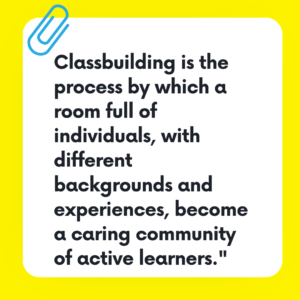The first week of school is known for its fair share of icebreakers. Name games, Find Someone Who…, and other get-to-know-you activities seem to take up our time, yet, are never heard of again once weeks 3 or 4 hit.
What if you changed that? What if you intentionally built in time for classbuilding and teambuilding throughout the entire school year?
I’m here to testify that building in that time made the greatest impact in class culture compared to anything else I was doing. And, as a fairly no-frills teacher, I can promise you that adding classbuilding to your schedule can be as simple or complicated as you’d like it to be.
What is Classbuilding and Teambuilding?
According to author Spencer Kagan, Classbuilding and teambuilding are two separate ideas that work together to create a positive and safe class culture.

Teambuilding, on the other hand, “…does for the team what classbuilding does for the class.”
Traditionally, I’ve done CB and TB with non-academic material. My case for setting aside time for non-academics is that students desire to build relationships with one another outside of what’s being learned. If you can make the relational deposit frequently, then learning and time on task will increase.
Yet, you can always add some academic material to your class or teambuilding time. The goal is to bring students together with one common goal!
Why Classbuilding and Teambuilding?
Kagan continues to write that CB and TB “actually change brain chemistry in ways that make students more likely to focus on and retain academic content.”
It works to take strangers and turn them into friends, thus relieving anxiety and promoting relaxation, a necessary tool needed for learning.
True, not all students will be friends, but their anxiety will decrease as they become more familiar with those in their class. Think back to when you were a student or even as an adult learner. Imagine you’re in a classroom with complete strangers, and you’re being asked to work together. My anxiety rises just thinking about it! The fear of saying the wrong thing or making the wrong move is more prevalent than my desire to work together.
Now, imagine you’re in a room with people you have just gotten to know. Each person knows the other one’s name and at least 1 or 2 interests. While you might still feel slightly overwhelmed, your anxiety will not be as high as being in a room of total strangers. Connections are made, learning takes place, and relationships slowly form to become the foundation for your time together.
How does this practically look?
Classbuilding and teambuilding should be a part of EVERY grade level. Below is a sample schedule of how you might fit in CB and TB at your grade level:
Elementary or Self-Contained: Build in 30 minutes once a week. I usually did it on Wednesday mornings, right after Morning Meeting and before Chapel.
CB and TB were non-negotiable. It was never tied to rewards or consequences, and if that time didn’t work, I made sure to find another time during the week.
Since you have more time, I suggest purchasing Kagan’s “Silly Sports and Goofy Games.” If you search “Silly Sports and Goofy Games,” the Kagan website has 3 or 4 free games.
4 of my favorite games have been:
Classbuilding:
- Blind Caterpillar
- True Blue Kangaroo
Teambuilding (groups of 4 or 5 preferably their cooperative learning groups):
- Balloon Carry
- Magic 11
Secondary or Block Schedule: Since you only see your students 2 or 3 times a week, set aside 10 minutes for CB. If you use cooperative groups, then incorporate teambuilding at least twice a month. You’ll be amazed at the community building that happens even when a seemingly short amount of time is set aside for non-academic, relationship building.
You might use the following games/activities:
- “Silly Sports and Goofy Games” Magic 11
- This or That slide. This is where you put up 2 different items (ex. hamburgers vs. hotdogs) and have students move to the side of the room that matches their choice. They discuss with their side first, then partner up with someone from the opposing side to share and listen.
- Rose-Rosebud-Thorn. I would recommend doing this later in the year, especially once students begin to build trust and respect. In a circle or two circles, students share their rose (what’s gone well that week), their rosebud (what they’re looking forward to), and their thorn (something that didn’t go well).
In the secondary classroom, you might also illicit student suggestions for CB and TB activities. Take a poll and ask them what activities they would like to do to build positive and meaningful relationships with their teacher and peers.
Ultimately, CB and TB reflect how we were created: to be in relationship with others and building one another up. Paul writes, “As far as it depends on you, live at peace with everyone” (Rom. 12:18).
I’ll leave you with this thought: How does CB and TB reflect and promote the sort of relationships we’re called to have with one another? How can you build in time for CB and TB to promote living at peace with everyone in your classroom?
May you be encouraged and blessed to try something new this year!
